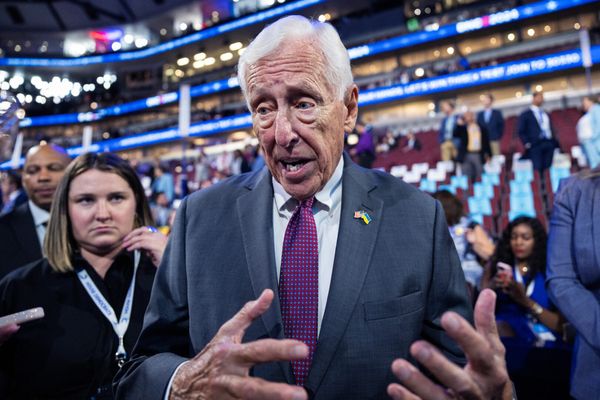
On Saturday, Cincinnati Reds rookie infielder Elly De La Cruz continued his standard practice is setting Major League Baseball on fire with a three-stolen base sequence in two pitches against the Milwaukee Brewers. De La Cruz has been a star from Day 1 with his athletic attributes, and this just added to the legend.
Elly De La Cruz stole second, third and home in the span of two pitches!
(MLB x @Ziprecruiter) pic.twitter.com/tOogXBGcpi
— MLB (@MLB) July 8, 2023
As Ohio sports media staple Mike Petraglia pointed out, that hadn’t been done by a Reds player in a very, very… VERY long time.
There's never been a player like Elly De La Cruz in the 154-year history of baseball's first professional franchise. Greasy Neale was the last Cincinnati Reds player to steal second, third and home in the same inning on Aug. 15, 1919.
— Mike Petraglia (@Trags) July 8, 2023
If you’re a bit of a football historian, you may know Earle “Greasy” Neale’s name, and this is where the story gets really interesting. Neale played for the Reds from 1916 through 1924, and he was on the team that “beat” the infamous Black Sox in the 1919 World Series. Not that Neale was an innocent bystander — he had 10 hits in that series.
But as much as Neale accomplished in professional baseball, his football deeds are even more notable. He coached the Philadelphia Eagles from 1941 through 1950, helped to develop the four-defensive back defense, amassed a 63-43-5 regular-season record, and won two straight NFL championships in 1948 and 1949. Neale held the Eagles’ franchise record for head coaches until Andy Reid broke it in 2004, which is pretty notable.
So, Neale starts to look like a bit of a sports Forrest Gump with his predilection for being in the right historical place at the right time. However, he wasn’t always on the right side of the ledger. When the Cleveland Browns moved from the All-America Football Conference to the NFL in 1950, NFL Commissioner Bert Bell saddled the new kids with what he thought would be a fearsome teat — the two-time champs at Philadelphia’s Municipal Stadium.
Problem was, as great a coach as Neale was, he severely underestimated the Browns and their head coach, Paul Brown. A 35-10 loss for Neale and the Eagles was the result.
From my book, The Genius of Desperation:
NFL Commissioner Bert Bell didn’t waste any time in setting up a stern test for the new kids—the four-time AAFC champs would begin their NFL journey with an opener against the two-time NFL champion Philadelphia Eagles, a tough, old-school team with a dynamic rushing attack led by Steve Van Buren, and a defense that had shut out the Rams in the previous championship game, 14-0. The Eagles had allowed the fewest points and scored the most in 1949, so this game was a clear message to the best team in the AAFC—you may have been a big fish in a small pond, but the NFL is the ocean.
“If you could feel cocky before a game, we felt cocky,” Eagles running back Bosh Pritchard said years later. “This was a team from what we thought was maybe a bush league… but they weren’t.”
According to Pritchard, Eagles head coach Earl “Greasy” Neale didn’t scout the Browns before the game. He apparently thought Brown was little more than a high-school coach, and that the Eagles wouldn’t have to do much to beat Brown’s team.
“I played for Greasy for quite a few years,” quarterback Tommy Thompson later said. “He made very, very few mistakes, but I believe he made a mistake on [not] scouting this ballclub.”
Brown, well-schooled in motivational tactics, used pre-game articles debasing his team’s readiness to face up against the Eagles as bulletin-board material.
“I really think that was our motivation,” Browns running back Marion Motley said. “When we got to Philadelphia, reading [these] newspaper[s] for two weeks, we were ready to hit anything the Eagles had.”
Not that the Eagles were oblivious to Brown’s strategy—at least, if they read the newspapers. The September 7, 1950 edition of the Philadelphia Inquirer has a story from sports reporter Frank O’Gara, who spoke with “an unusually unreliable source, who doesn’t wish to be identified.” This source, or O’Gara himself, posited that “the Clevelanders are of the opinion that quick passes, chiefly of the hook variety, will riddle the Eagles’ revolving defense and set up victory in the long-awaited football classic.”
Brown’s game plan was indeed to rattle Neale’s defenses with flare passes to his backs and deep passes down the sidelines. Neale, Philadelphia’s head coach since 1941, had devised his “Eagle” defense through the 1940s with a five-man line, two linebackers, and the first four-man secondary.
It worked well enough against NFL offenses, but Brown had done the scouting Neale hadn’t. He theorized that if he expanded the offensive line spacings and put his halfbacks in motion and out to catch passes to either sideline, Neale’s linebackers would have to move out of the middle of the field. Brown had tried this a bit against the Detroit Lions in the preseason; “only briefly so as not to tip our hand,” Brown later wrote, “but each time, their defense reacted as we had hoped.” Sending left halfback Alex Bumgardner in motion to pull a linebacker out of the middle was a key component of this strategy
This left a huge middle gap wide open for slants and crossing patterns. Brown also implemented a double-wing formation, with two receivers to one side, forcing single coverage from Neale’s defensive backs. Brown cited one mismatch in particular—Eagles cornerback Russ Craft trying to cover halfback Dub Jones one-on-one.
The second part of the Browns’ strategy showed just how clinical Brown could be when diagnosing an opponent’s personnel and strategies. He theorized that since Neale’s defensive linemen were taught to line up outside opposing offensive linemen, moving his offensive linemen farther and further apart as the game went on would naturally place the defensive linemen farther apart from each other, setting Philadelphia’s defensive line up for the Marion Motley draw plays by widening the splits and leaving the linebackers alone to deal with Motley at the second level—not a pleasant proposition for any linebacker. Motley ran 11 times for 48 yards, becoming more of a factor in the second half when Brown wanted his offense to control the ball.
“I’ll never forget Alex Wojciechowicz looking around for his defensive tackles and suddenly signaling for time-out,” Brown wrote. “We could hear him yelling at his tackles to stay close. They made the mistake—as the Lions did—of lining up on our offensive linemen instead of taking their normal spacing from the ball, and they never adjusted to it. I couldn’t help thinking back to our first game at Ohio State against Missouri, and how we saved the day by keeping our normal spacing.”
Still, quite an estimable career for Greasy Neale. Maybe Elly De La Cruz has a future as an NFL coach? Until then, as Cincinnati Reds base-stealers go, Greasy Neale still stands alone.







